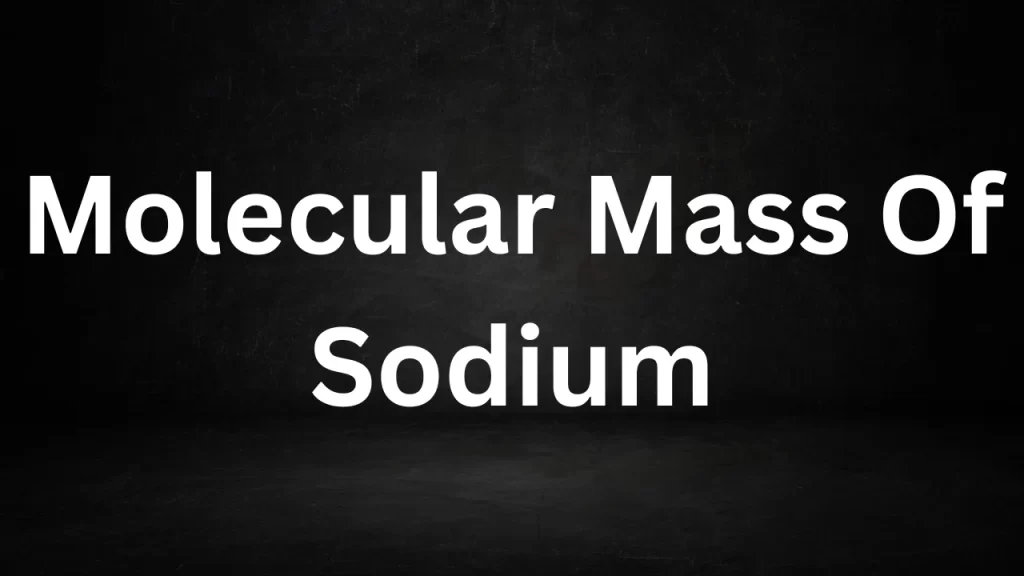Tag: sodium bromide molecular weight
Molecular Mass Of Sodium
Molecular Mass Of Sodium: Sodium, with the chemical symbol “Na” derived from the Latin word “natrium,” is a chemical element that plays a crucial role in various aspects of our daily lives.
Understanding the molecular mass of sodium is fundamental in chemistry, as it helps scientists and researchers predict how sodium interacts with other elements and compounds. In this article, we will delve into the molecular mass of sodium, its significance, and its applications.

Molecular Mass Of Sodium
The Atomic Structure of Sodium
To comprehend the molecular mass of sodium, it is important to first explore its atomic structure:
- Atomic Number: Sodium is identified by its atomic number, which is 11. This signifies that a sodium atom contains 11 protons in its nucleus.
- Electron Configuration: Sodium has an electron configuration of 2-8-1, meaning it has two electrons in its first energy level, eight in its second energy level, and one in its third energy level.
- Isotopes: Sodium has several isotopes, but the most abundant and stable isotope is sodium-23 (Na-23), which has 12 neutrons in addition to its 11 protons.
Molar Mass vs. Molecular Mass
It is essential to differentiate between molar mass and molecular mass. Molar mass refers to the mass of one mole of a substance, often expressed in grams per mole (g/mol). Molecular mass (or molecular weight) typically refers to the mass of a molecule, which consists of two or more atoms chemically bonded together. Sodium, as an element, does not form diatomic molecules like hydrogen (H2) or oxygen (O2), so its molecular mass is the same as its atomic mass.
Calculating the Molecular Mass of Sodium (Na)
To calculate the molecular mass of sodium, we can use the atomic mass of sodium-23 (Na-23):
- The atomic mass of sodium-23 is approximately 22.99 atomic mass units (amu) or 22.99 g/mol.
- Therefore, the molecular mass of sodium (Na) is approximately 22.99 g/mol or 22.99 amu.
Significance of Molecular Mass in Sodium
The molecular mass of sodium is a crucial parameter with significant implications in various fields:
- Chemical Reactions: Sodium readily forms compounds with other elements, such as chlorine (NaCl) or oxygen (Na2O). The molecular mass of sodium is essential for stoichiometry, helping determine the amounts of reactants and products in chemical reactions.
- Biological Processes: Sodium ions (Na+) are vital in biology, playing a key role in nerve impulse transmission, muscle contraction, and maintaining electrolyte balance in the human body.
- Metallurgy: Sodium is used in the extraction of certain metals, such as titanium and zirconium, from their ores. Its molecular mass is relevant in metallurgical processes.
- Alloys: Sodium can be incorporated into alloys, such as sodium-potassium alloy, which has applications in heat transfer and cooling systems.
- Nuclear Reactors: In certain nuclear reactors employing liquid metal cooling systems, sodium serves as a coolant. The mole mass of sodium is important in the design and operation of such reactors.
Conclusion
Sodium, with a mole mass of approximately 22.99 g/mol or 22.99 amu, is a fundamental element in chemistry and biology. Its molecular mass is a crucial parameter in various chemical reactions, biological processes, and industrial applications. Sodium’s role in our daily lives extends from table salt (sodium chloride) to essential bodily functions, illustrating the significance of understanding its molecular mass and its behavior in various contexts.
Read More
- Molecular Mass of Sucrose
- Molecular Mass of Chlorine
- Molar Mass Of C2H5OH
- Molecular Weight of Co2
- Molecular Mass of Water
Frequently Asked Questions (FAQs) mole Mass Of Sodium
What is the mole mass of sodium?
The mole mass of sodium (Na) is approximately 22.99 grams per mole (g/mol) or 22.99 atomic mass units (amu). It represents the mass of one mole of sodium atoms.
How is the mole mass of sodium calculated?
The mole mass of sodium is calculated using the atomic mass of its most abundant and stable isotope, sodium-23 (Na-23), which has an atomic mass of approximately 22.99 amu or 22.99 g/mol.
What is the significance of knowing the mole mass of sodium?
Knowing the mole mass of sodium is important in various fields, including chemistry, biology, and industry. It is crucial for stoichiometry in chemical reactions, understanding the behavior of sodium compounds, and its role in biological processes such as nerve signaling and muscle contraction.
What are some common compounds of sodium?
Sodium forms numerous compounds, including sodium chloride (table salt, NaCl), sodium hydroxide (caustic soda, NaOH), sodium carbonate (soda ash, Na2CO3), and sodium bicarbonate (baking soda, NaHCO3), among others. These compounds have various industrial, culinary, and chemical applications.
Why is sodium important in biological processes?
Sodium ions (Na+) are essential in biological processes such as nerve impulse transmission, muscle contraction, and the maintenance of electrolyte balance in the human body. Sodium channels in cell membranes allow for the passage of sodium ions, facilitating electrical signaling.